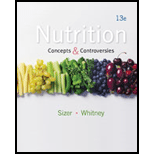
Nutrition: Concepts and Controversies
13th Edition
ISBN: 9781133603184
Author: Frances Sizer, Ellie Whitney
Publisher: Cengage Learning
expand_more
expand_more
format_list_bulleted
Concept explainers
Question
Chapter 3, Problem 10SC
Summary Introduction
Introduction:
The large intestine is found as the last portion of the digestive tract or gastrointestinal tract. It mainly functions to convert the digested food into the feces and absorbs the water and minerals from the digested food. It is found to be smaller and thicker than the small intestine.
Expert Solution & Answer
Trending nowThis is a popular solution!

Chapter 3 Solutions
Nutrition: Concepts and Controversies
Knowledge Booster
Learn more about
Need a deep-dive on the concept behind this application? Look no further. Learn more about this topic, health-nutrition and related others by exploring similar questions and additional content below.Similar questions
- The bile from the liver is delivered to the _______. a. stomach b. liver c. small intestine d. colonarrow_forwardExplain the differences between the digestion roles of the small and large intestines. Does the appendix also have a digestive function?arrow_forwardFigure 34.11 Which of the following statements about the digestive system is false? Chyme is a mixture of food and digestive juices that is produced in the stomach. Food enters the large intestine before the small intestine. In the small intestine, chyme mixes with bile, which emulsifies fats. The stomach is separated from the small intestine by the pylloric sphincter.arrow_forward
- Figure 16.7 Which of the following statements about the digestive system is false? a. Chyme is a mixture of food and digestive juices that is produced in the stomach. b. Food enters the large intestine before the small intestine. c. In the small intestine, chyme mixes with bile, which emulsifies fats. d. The stomach is separated from the small intestine by the pyloric sphincter.arrow_forwardFigure 34.12 Which of the following statements about the small intestine is false? Absorptive cells that line the small intestine have microvilli, small projections that increase surface area and aid in the absorption of food. The inside of the small intestine has many folds, called villi. Microvilli are lined with blood vessels as well as lymphatic vessels. The inside of the small intestine is called the lumen.arrow_forwardList the organs and accessory organs of the digestive system. On a separate piece of paper, list the main functions of each organ.arrow_forward
- Figure 34.19 Which of the following statements about digestive processes is true? Amylase, maltaseT and lactase in the mouth digest carbohydrates. Trypsin and lipase in the stomach digest protein. Bile emulsifies lipids in the small intestine. No food is absorbed until the small intestine.arrow_forwardWhat are the main functions of the stomach? What roles do enzymes and hormones play?arrow_forward
arrow_back_ios
arrow_forward_ios
Recommended textbooks for you
 Concepts of BiologyBiologyISBN:9781938168116Author:Samantha Fowler, Rebecca Roush, James WisePublisher:OpenStax College
Concepts of BiologyBiologyISBN:9781938168116Author:Samantha Fowler, Rebecca Roush, James WisePublisher:OpenStax College Comprehensive Medical Assisting: Administrative a...NursingISBN:9781305964792Author:Wilburta Q. Lindh, Carol D. Tamparo, Barbara M. Dahl, Julie Morris, Cindy CorreaPublisher:Cengage Learning
Comprehensive Medical Assisting: Administrative a...NursingISBN:9781305964792Author:Wilburta Q. Lindh, Carol D. Tamparo, Barbara M. Dahl, Julie Morris, Cindy CorreaPublisher:Cengage Learning Human Biology (MindTap Course List)BiologyISBN:9781305112100Author:Cecie Starr, Beverly McMillanPublisher:Cengage Learning
Human Biology (MindTap Course List)BiologyISBN:9781305112100Author:Cecie Starr, Beverly McMillanPublisher:Cengage Learning




Concepts of Biology
Biology
ISBN:9781938168116
Author:Samantha Fowler, Rebecca Roush, James Wise
Publisher:OpenStax College

Comprehensive Medical Assisting: Administrative a...
Nursing
ISBN:9781305964792
Author:Wilburta Q. Lindh, Carol D. Tamparo, Barbara M. Dahl, Julie Morris, Cindy Correa
Publisher:Cengage Learning

Human Biology (MindTap Course List)
Biology
ISBN:9781305112100
Author:Cecie Starr, Beverly McMillan
Publisher:Cengage Learning